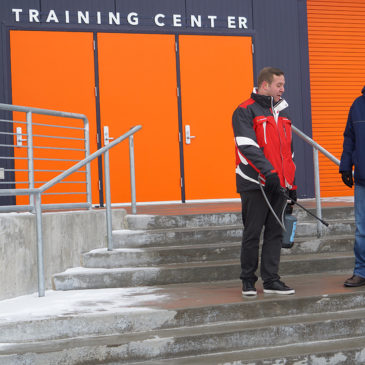Nate Clemmer’s family wanted to go somewhere warm for Thanksgiving last year.
But Lake Placid was about to get hit with their first winter weather event of the season, and Clemmer needed to be there.
“While my kids were in the hotel room watching television, I was out in the parking lot testing different products,” said Clemmer, CEO of SynaTek Solutions, a Philadelphia-area company that develops organic de-icing alternatives to road salt.
Scientific evidence is mounting on the impacts of road salt on Adirondack lakes and watersheds.
New York State is the largest user of road salt in North America. Six million tons of salt have been deposited on Adirondack roads over the past 35 years, according to the Paul Smith’s College Adirondack Watershed Institute (AWI).
Local soils are thin and porous, which means most of this salt ends up in ground and surface water.
Levels in Lake George have increased threefold in the past four decades.
In Lake Placid, the Ausable River Association determined there are “significant long-term trends” of increasing sodium and chloride buildup in Mirror Lake, with concentrations up to 11 times higher than in the early 1970s.
This decline in water quality can have a deleterious effect on the environment, economy, municipal budgets — even property values.
Environmental groups are likening the salt buildup to the modern-day equivalent of acid rain, surpassing more well-known threats like stormwater pollution and invasive species.
“But the difference is you can solve it locally,” said Eric Siy, executive director of the FUND for Lake George.
‘Nothing Else Like It’
Siy was among the dozens of stakeholders gathered at the 3rd annual Salt Summit in Ticonderoga last week to discuss the latest science and best practices for reducing the use of road salt.
Among the keystones was an update on an innovative new pilot program designed to study salt application in the Lake George region.
For the past two years, the FUND for Lake George, who co-sponsored the conference, has been working with municipalities in the southern Adirondacks and an Ontario-based company called Viaesys to gather data.
A fleet of 20 plow trucks in eight municipalities has been outfitted with monitoring devices that measures applications and tracks exactly when and how much of the substance is being deployed — including during heavy weather events — and crunches the numbers.
“We do see there are a lot of potential areas of improvement — especially with training,” said Viaesys CEO Raqib Omer. “We do see some cases where a little bit of training can go a long way with the operators.”
To gauge the impact on public safety, cameras have been mounted at key locations in Lake George.
“We’re actually getting comparable or better results in terms of pavement conditions on those roadways with less salt,” said Siy.
Stakeholders aim to then take that data and develop best practices.
“There is nothing like it being done anywhere on the planet where we are connecting the dots of research and practical application of techniques to reduce the use of road salt,” Siy said.
‘Dramatic Impact’
While the long-term effect of salination requires further study, the impacts may have a cascading effect on the ecosystem, impacting species at the base of the food chain like phytoplankton and zooplankton, which serve as feed for fish and amphibians.
“If you see salt levels becoming too high and you’re dealing with native species in the lake that are salt-intolerant, it can upset the balance of the food web and have a dramatic effect on what everybody comes to expect when they come to Lake George,” Siy said.
Salt also can leach into groundwater supplies, like in Beekmantown in Clinton County, where the town is working with the state Department of Environmental Conservation on a remediation plan for contaminated wells.
While the taste can be inconvenient, there’s also more serious health concerns, including leaching from heavy metals and the impact on those with dietary restrictions.
AdkAction, an advocacy group that co-sponsored the conference, is about midway through testing 400 wells throughout the Adirondack Park.
“We hope it will give us a better understanding of the severity of the groundwater situation,” said Brittany Christenson, the group’s executive director.
AdkAction is also researching the impacts of salt on state and private vehicles, as well as on roadway infrastructure.
Dialogue Important
The AWI report revealed 84,700 tons of salt is applied to local roads, a number that rises to 108,000 for their state counterparts.
The report directly tied increased chloride levels to the latter owing to a higher road density.
“We’re trying to get the state of New York right now to eliminate the amount of salt it puts on Main Street in Lake Placid,” said North Elba Supervisor Roby Politi. “We all contribute, but the state contributes more. Salt is at a minimum in the Town of North Elba, but the state of New York is 100 percent.”
The state Department of Transportation dispatched a panel of staffers to the conference, a prospect that heartened stakeholders.
“That part of the dialogue is very important,” said Lake George Waterkeeper Chris Navitsky.
Bryan Viggiani, a DOT spokesman, said the agency has long worked with local officials and advocacy groups within the Lake George watershed and statewide on road maintenance practices that protect both the environment and public safety.
“What we heard at the summit was that all users of road salt — both public and private — are contributing to increased salinity in water bodies within the watershed,” Viggiani said via email.
The state employs a number of best management practices to reduce salt use while still protecting motorists, said Viggiani, including reducing application rates, using automated material spreaders to control salt use, calibrating equipment routinely, using GPS in equipment and applying salt brine and alternative materials when appropriate.
“It is incumbent upon every snow and ice practitioner to utilize best management practices to minimize salt use,” Viggiani said. “The New York State Department of Transportation continually refines its winter maintenance practices to provide for safe travel with minimal environmental impacts.”
Navitsky said the coalition imagines a scenario in which all stakeholders benefit.
“Better equipment, better approaches and better practices will make it more efficient for the towns and save them money while maintaining safe roads and protecting our environment in the long run,” he said.
Ticonderoga Supervisor Joe Giordano called the research “eye opening.”
“When (highway superintendents) see the bottom line — which everyone is looking at when it comes to savings — that will be a bigger take-home message as well,” Giordano said.
Reducing salinity also requires support from the general public.
“Unless you do this in a way that has road safety as the paramount concern, you are not going to get broad buy-ins in reducing the use,” Siy said.
AdkAction hopes their “hold the salt” campaign — which includes car magnets — will boost awareness.
Others say the public will pay more attention if the issue is brought directly to their doorsteps — literally.
Branch Creek, a subsidiary of SynTek Solutions, has developed a biodegradable de-icing agent called Entry.
The product, Clemmer said, is designed for small-scale applications — namely a 15-foot radius outside of homes, businesses, hospitals and public sidewalks.
While Entry was designed to be environmentally-friendly, customer feedback reveals the chief selling point is that it cannot be tracked indoors — not necessarily because of the environmental ramifications.
But Clemmer said it’s important to keep hammering on the green elements in order to facilitate a broader public conversation.
“If we’re going to be successful in reducing salt in Lake George and the Adirondack region as a whole, we need to get people that live in this community to understand that,” he said.



